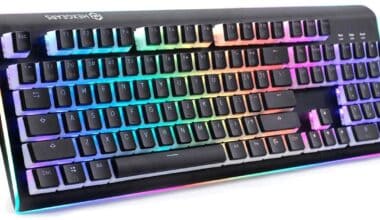Is your paperwork getting a little cluttered all over the cabinet, desk, and living areas?
If yes, then it is time to get a filing cabinet.
Talking about filing cabinets, you should get one sturdy and big enough to store a significant amount of paperwork while protecting it from wear and tear.
In general, Lateral file cabinets come in various sizes with the most common widths of 30″, 36″, 38″, 42″, 44″ and depth of 15″ to 20″. With two to five wide drawers at your disposal, you can store and retrieve multiple files in one go, including legal, letter-size, and odd-sized documents.
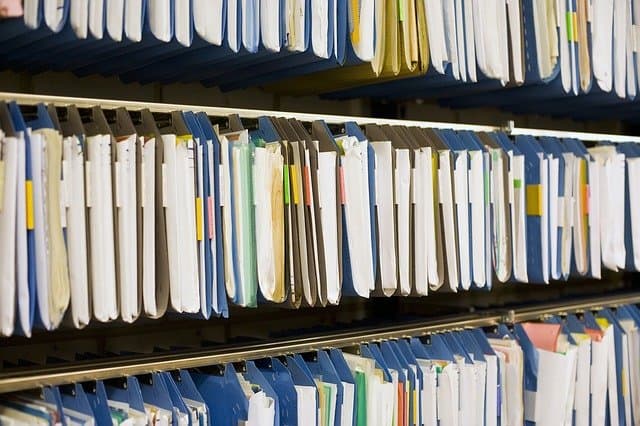
Moreover, they help save space and enhance the décor of the home office. If you want to buy a lateral filing cabinet for your home office, you have to come to the right place!
Check out this lateral filing cabinet guide to choose a perfect filing cabinet for your home office.
Table of Contents Show
What is Lateral Filing Cabinet?
A lateral filing cabinet refers to a lateral-shaped file storage unit.
The lateral cabinet’s drawers extend from side to side instead of top to down, holding more sheets (papers) than a vertical cabinet.
They are specifically designed to store odd-sized files, which comes as a boon, given their wide drawer sizes.
However, installing a lateral filing cabinet may take more wall space than a vertical cabinet because of its side-to-side design.
If you are trying to fit a lateral filing cabinet in a small room, consider using overhanging lateral cabinets that free up the floor space.
Otherwise, choose a 2-drawer lateral cabinet that is too small to be noticed.
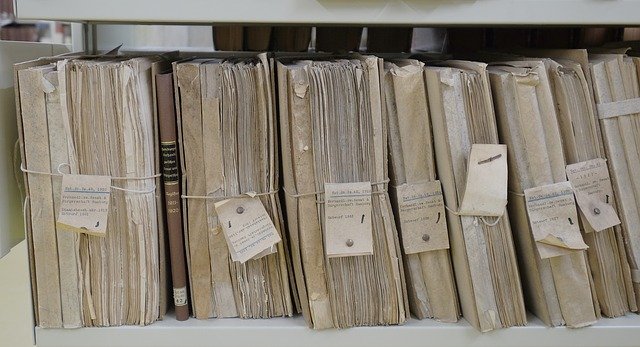
Advantages of Using Lateral Filing Cabinets
Using lateral filing comes with many benefits. Here are the three advantages of choosing a lateral filing cabinet for your home office.
1. It Holds More Paperwork
The lateral cabinet certainly holds more files than vertical cabinets because it can store side to side through the length of the drawer.
Did you know that you can store about 6,000-10,000 sheets in a single drawer of a lateral filing cabinet?
The lateral cabinet could prove to be a Messiah for an office that deals with a lot of paperwork.
A medium-sized lateral cabinet can hold over 200 pounds (92 kg) of papers at any given time, which will cut on clutters.
2. Quickly Locate a File or Paperwork
Because a single drawer of the lateral cabinet could hold almost three times more files than the vertical cabinet, you can quickly retrieve the required file in one go.
It saves a lot of time for the workers who deal with a significant amount of paperwork regularly.

The lateral storage also makes it easier to store a bulk of similar files in a single drawer, such as in the hospital, government offices, and law firms.
Related Article: How to Organize Home Office Filing System?
3. It Holds Odd-sized Files or Folders
Unlike vertical storage units that only hold letter-sized files or folders, lateral storage can take in all files, including legal and odd sizes.
It can be a lifesaver for offices that use odd-shaped paperwork, such as surveying, printing, and architecture firms.
Hence, a lateral filing cabinet will be helpful for professionals and offices.
Read about Home Office Desk Having Drawers
Standard Dimension of Lateral File Cabinets
Before buying a lateral cabinet, you should understand how its dimension will help measure its position and storage in your office.
When measuring an item like a cabinet, consider the three dimensions or 3D. You should measure a lateral cabinet in height, width, and depth.
- Height = The vertical length of the filing cabinet.
- Width = The horizontal length of the filing cabinet measured from left to right.
- Depth = The length or the cabinet measured from the backside to the front.
When you multiply the three numbers, you get a dimension in cubic inches or feet that will help determine how many floors and wall space your lateral cabinet will take.
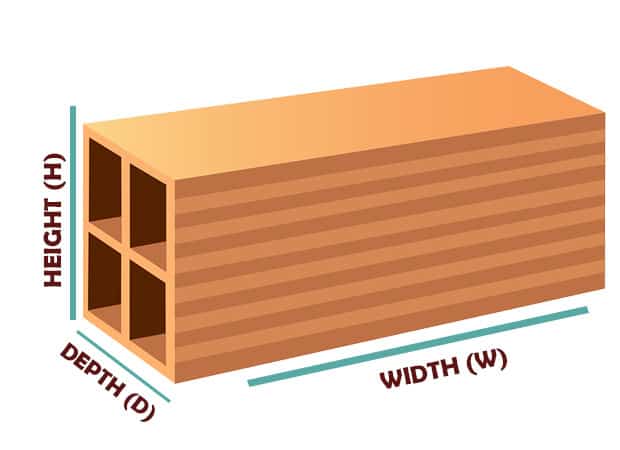
The makers offer three different sizes of lateral cabinets; small, medium, or large.
| Cabinet Size | Drawers | Dimensions |
|---|---|---|
| Small | 2 | 23” Depth x 35” Width x 29 Height |
| Medium | 3 | 23" Depth x 42" Width x 40.5"Height |
| Large | 4 or more | 23” Depth x 35” width x 54” Height |
Small and medium lateral cabinets will have two to three drawers 26″ to 30″ wide. A large cabinet may have two or more drawers with widths 36″ or more.
However, a custom-sized lateral cabinet may have varying depths, heights, or widths, making them different from one cabinet to another.
Check out the factors that may determine a lateral file cabinet’s dimensions and holding capacity.
Also, read about setting up your minimalist desk in home office.
1. Standard Depth of Lateral File Cabinets
Lateral cabinets boast more width than depth, where vertical cabinets tend to have 24% more depth than lateral ones.
| Cabinet Type | Average Depth |
|---|---|
| Vertical | 591 mm or 23.26 inches. |
| Lateral | 514.16 mm or 20.24 inches |
However, the cabinet’s drawer depth may differ from the cabinet’s overall depth.
If the overall depth of lateral cabinets is 20.24 inches (514.16mm ), the cabinet drawer would be 19.75 inches (501.66mm), on average.
The depth of lateral file cabinets may start from 17.7 inches and go up to 233/8 inches, depending on your cabinet size.
Thus, consider cabinets with an optimum depth, so it does not take up enough floor space. Choose cabinet drawers 18-19″ deep that will easily fit your letter-size and legal-size (18¼”) files.
2. Standard Width of Lateral File Cabinets
Lateral filing cabinets are wider than they are deep. They are designed to hold more files in a single drawer.
The more drawers indicate the higher capacity of your filing cabinet.

Let us take a look at this table for the standard width of lateral cabinets.
| No. of Drawers | Typical Width (in inches) |
|---|---|
| 2 | 30 |
| 3 | 36 (33¼ inches of filling space) |
| 4 | 38-42 |
| 5 | 44 (39¼ inches of filling space) |
Unlike vertical filing, lateral filing drawers can be arranged in two ways; running front-to-back or as two rows side-by-side.
The wider drawers offer more flexibility to hold much paperwork, including data printouts or odd-sized files.
Today, most lateral cabinets come with low-profile drawers that make storing and retrieving files while sitting on a chair is easy.
3. Standard Height of Lateral File Cabinets
The height of a filing cabinet will increase or decrease depending on the number of drawers and cabinet sizes.
You will mostly find lateral cabinets in these heights.
| No. of Drawers | Typical Height (in inches) |
|---|---|
| 2 | 28 |
| 3 | 40 |
| 4 | 50-53 |
| 5 | 64-66 |
A 26-30 inches high lateral cabinet with two drawers will be appropriate for a small home office.
The higher the cabinets, the more drawers it has.
Hence, it is better to stick with a small lateral cabinet for the home office because you would not deal with much paperwork, unlike busy offices.

Another essential factor to consider is the available floor and wall space.
Installing a sizeable lateral filing cabinet can prove liability because it will take up a significant amount of floor and wall space that otherwise could be used for other essential purposes.
Pro Tip: Choose lateral cabinets at least 40 inches and 53 inches in height for an office with a significant filing need.
Storage Capabilities of Lateral File Cabinets
The storage capability of a lateral file cabinet will depend on its dimensions and the number of drawers.
Any filing cabinet’s storage capacity is measured in weight (lbs. or kg) or cubic inches and cubic feet.
Find the Standard Weight of a Filing Cabinet.
1. Calculate the Storage Capacity
Use this simple math to calculate the total storage capacity of any filing cabinet’s drawer in inches.
For example, the width of a drawer is 12 inches, height is 16 inches, and depth is 10 inches.
Multiply these number (12 x 16 x 10) to get = 1920 cubic inches.
Similarly, calculate the total capacity of the entire cabinet by multiplying the number of drawers by 1920 cubic inches, where 1920 cubic inches x 3 drawers will be 5,760 cubic inches.
It means a single cabinet can take 5,760 cubic inches in storage.
The number of drawers will depend on their height. A standard 28″ high cabinet will have two drawers, while a 64″ cabinet will have up to five or more drawers.
2. Calculate the Sheet Storage
According to Recordnations.com, you can fit around 150-200 sheets per inch of space.
So, if your filing sheet is 10″ or less in size, you can fit around 1,800-2,400 sheets in a 12″ Width x 10″ Depth drawer.
If you multiply that with three drawers, you could file store around 5,400-7,200 sheets in a single cabinet.
Choosing the Right Lateral File Cabinet for Home Office
Choosing the right lateral file cabinet for your home office can be tricky because not all home offices are the same size.
Whether you’re having trouble keeping track of your prints or trying to get a sound filing system for all paperwork, investing in an appropriate filing system will pay off.
In addition, you would need to determine your paperwork and storing files.
1. Measure for the Perfect Fit
Start with considering the size of your room vs. the available storage space.
You would not want a large cabinet to take up essential space in your room, so choose a filing cabinet that does not take over 1/10th of the room’s area.
A lateral file cabinet saves storage space because lateral drawers have less depth and floor space.
Another thing to consider is your file size. You will need a lateral cabinet with more depth if you have many oversized documents.
A 2-drawer filing cabinet measuring 35″ W x 23″ D x 29-30″ H will suit a small home office.
2. Strength of the Cabinets
Another thing to consider is the strength of the cabinet. Again, the material and weight of the cabinet primarily determine its strength.
Consider adding lateral metal cabinets to your home office if you want a sturdier filing system that lasts longer. Otherwise, choose a wooden lateral cabinet.

A metal cabinet will weigh less than wood cabinets but will be more durable. At the same time, wood cabinets with laminate or mahogany finish add an aesthetic appeal to your home office.
Another essential thing to consider is safety. Choose a filing cabinet with a locking system, such as an interlocking drawer system, to keep the prying eyes away.
3. Color and Decor
Unlike corporate offices, the home office is a private space with a homely décor.
Cabinets with a dark or white finish are the favorite for any home office because they perfectly match any interior.
Be careful when choosing a metal cabinet because they are challenging to match with the room’s decor.
Choose lateral wood cabinets instead, as they come in many different colors and designs.
4. Cabinet Dimensions
Consider the appropriate lateral cabinet dimension to determine the space it would take in your home office.
Most home offices are located in the bedroom or a spare room, less available storage space lesser.
Therefore, for a typical home office, you should consider lateral cabinets with a height and width lesser than 20 and 25 inches.
A small or medium cabinet with two or three drawers should be enough because you deal with less paperwork at home.
5. Budget
A large and expensive lateral cabinet in the home office will not help save expenses; thus, choose an affordable yet durable cabinet.
A quality wood cabinet in small or medium sizes appropriate for home office may come for $150- $300.
For a slightly cheaper option, consider a lateral metal cabinet that may cost only $100-$200. However, the more inexpensive cabinets may limit the features and choices.
6. Cabinet Material
The price and strength of the lateral filing cabinet will depend on the material used.
Lateral filing cabinets are either made from sheet metal or wood, where a metal cabinet is more preferred for office uses because of its strength and durability.
However, not all metal cabinets are the same. You can find one made from aluminum as well as galvanized steel.
The latter is more preferred for its strength and durability; some even come in a fireproof design.
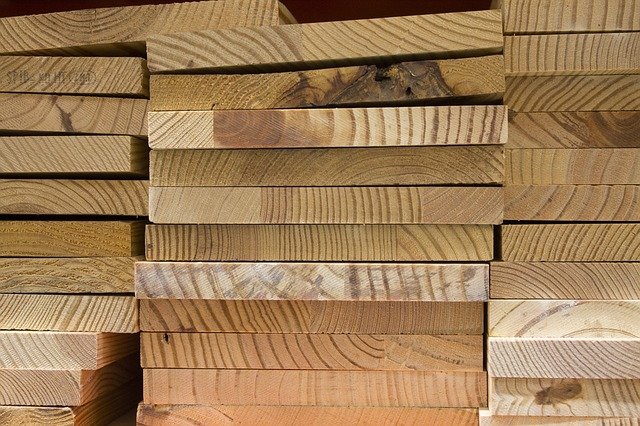
A cheaper wood cabinet is made from less durable particleboard.
The pricier and more durable options come from wood veneer (real-wood layers bonded over for strength) and solid wood (made entirely from tree lumber).
Lateral Filing Cabinets Recommendations
Here are a few Lateral Filing Cabinet recommendations for your home office.
| Product | Specification | Image |
|---|---|---|
| Bush Furniture Cabot 2 Drawer Lateral File Cabinet | Espresso Oak, ANSI/BIFMA standards, 2 drawers, 30.16" x 60lb. Holds letter, legal, and A4 files | 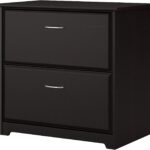 |
| DEVAISE Wood File Cabinet | 2 large drawers with lock, 23.6" W x 15.7" D x 29.3" H, 220lbs, eco-friendly wood material | 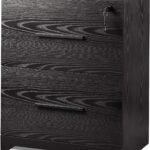 |
| Bonnlo 2-Drawer Lateral File Cabinet | 35.5"W x 17.7"D x 28.75"H, 330lb, center lock system, one-year warranty | 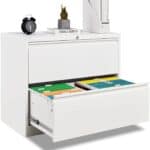 |
| HON Brigade 600 Series File Cabinet | Choose from 2-5 drawers, Clean metal finish, heavy-duty, 18 x 36 x 39.13 inches | 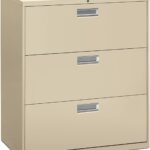 |
| Storex Plastic Two-Drawer File Cabinet | Polished plastic, removable casters, fits all sizes of files, 18-1/4 x 14-3/4 x 25-1/2 Inches | 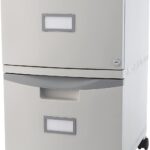 |
| Lorell 14341 18 Deep 2-Drawer File Cabinet | Two drawer file cabinet, Steel construction, glide suspension, 14.3" x 18" x 24" | 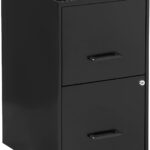 |
Final Verdict
A lateral filing cabinet can be used for more than storing just paperwork. You can store almost anything, papers, sketches, documents, office utensils, supplies, etc.
Choosing an appropriate lateral filing cabinet for your home office will clear your table and living space of clutters.
It can be a lifesaver when you have a small home office unit or bedroom cum office!
If you are still confused, use the guide above to find the perfect lateral filing cabinet for your home office.
Related Article: Are File Cabinets Fireproof?

